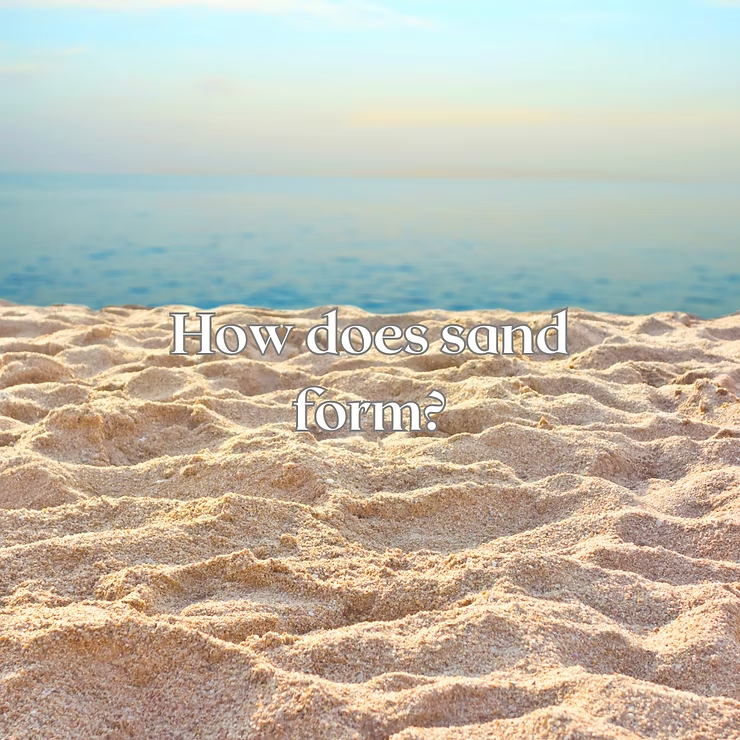Introduction
Sand is one of the most common natural materials on Earth, found on beaches, deserts, and riverbeds. It is composed of tiny particles that result from the weathering and erosion of rocks over time. Understanding how sand forms is important for industries such as construction and agriculture, as well as for environmental conservation. This article explores the composition of sand, its formation, the role of natural forces like water and wind, and its significance in both human use and ecosystems.
What is Sand Made of?
The Composition of Sand
Sand primarily consists of mineral particles, with quartz and feldspar being the most abundant. These minerals give sand its characteristic texture and color. Depending on location and parent rock, sand may also include minerals like mica or magnetite, adding unique properties to different sand types.
Different Types of Sand
- Beach sand: Fine-textured and light in color, often found along coastlines.
- Desert sand: Coarser, reddish or orange due to iron oxide content.
- River sand: A mix of sand, silt, and clay, widely used in construction.
Each type of sand is shaped by its origin, availability, and the processes that form it, making it suitable for specific applications.
How Does Sand Form?
Weathering and Erosion
Sand begins with the breakdown of rocks through physical and chemical weathering. Freezing and thawing cycles, combined with chemical reactions involving water and air, slowly fragment rocks into smaller grains.
Transportation and Deposition
Once formed, sand particles are transported by rivers, waves, and wind. Water carries grains across long distances, depositing them in riverbeds, deltas, or beaches. Wind, especially in arid regions, creates dunes by moving sand and depositing it when energy decreases.
The Role of Water and Wind
Water shapes sand by smoothing particles, while wind sculpts dunes through constant movement. These forces not only transport but also refine the texture of sand grains, giving rise to diverse landscapes.
The Formation of Sand Dunes
Wind as a Sculptor
Wind is the primary force behind dune formation. Depending on speed and direction, dunes may take different shapes. Strong winds create tall, steep dunes, while gentle winds form smaller, rounded ones.
Types of Sand Dunes
- Barchan dunes: Crescent-shaped with horns pointing downwind.
- Transverse dunes: Long ridges perpendicular to prevailing winds.
- Star dunes: Multi-armed dunes formed by shifting wind directions.
- Parabolic dunes: U-shaped with vegetation helping to stabilize them.
- Longitudinal dunes: Parallel ridges aligned with consistent winds.
The Importance of Sand
In Construction
Sand is essential in making concrete and mortar, forming strong foundations and structures. It also serves as a base for roads and as filler material in various projects.
In Agriculture
Sand improves soil aeration and drainage, particularly in loamy soils. Farmers use it in seed coating, potting mixes, and mulching to enhance crop growth.
In Recreation
From beaches and sandboxes to sports like sandboarding, sand plays an important role in leisure activities, making it both practical and enjoyable.
The Impact of Sand Mining
Environmental Consequences
Excessive sand mining disrupts ecosystems, causes erosion, and depletes habitats. It also threatens coastal protection and water systems.
Regulations and Sustainable Practices
- Licensing and permits for controlled extraction.
- Environmental impact assessments before projects begin.
- Rehabilitation efforts to restore affected ecosystems.
Alternatives to Sand Mining
- Recycled glass: Crushed glass replaces sand in construction.
- Crushed rock: Limestone or granite substitutes for sand in concrete.
- Fly ash: A coal byproduct used to reduce sand demand in construction.
Conclusion
Sand may appear simple, but its formation is shaped by powerful natural forces over time. It supports industries, enriches agriculture, and provides recreational spaces, yet faces challenges from unsustainable mining. Appreciating sand means recognizing its importance in both human society and the natural world.

